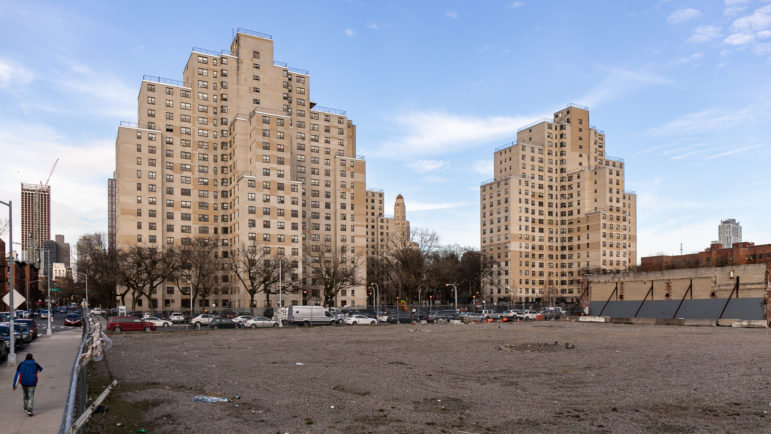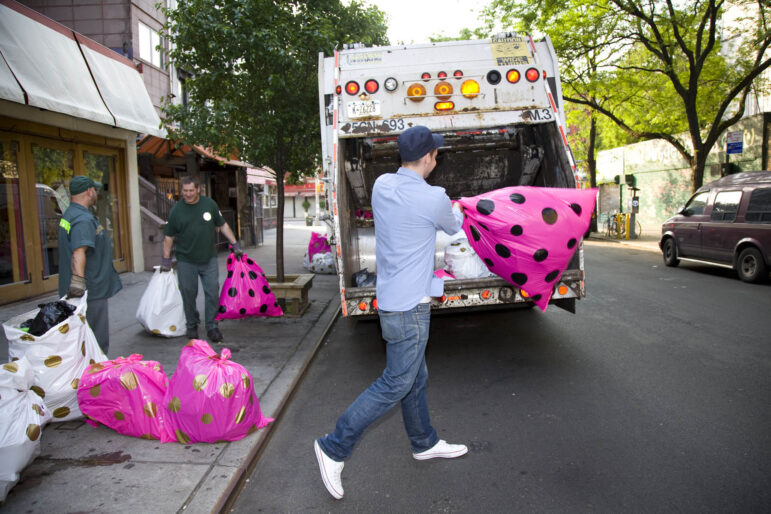At a Brooklyn Community Board 6 meeting Thursday, attendees raised questions about whether repairs for NYCHA complexes and opportunities for public housing residents would be included in the rezoning.

Adi Talwar
A view of NYCHA Wickoff Gardens from the intersection of Butler Street and Nevins streets.Brooklyn Community Board 6 and local elected officials reiterated that NYCHA repairs are the bottomline for a successful Gowanus rezoning plan, during a virtual Department of City Planning (DCP) presentation Thursday night attended by an estimated 300 residents and stakeholders.
The presentation was a “refresher” on the Gowanus proposal since the city announced it would certify the rezoning in January of next year. Several community board members on the Land Use and Landmarks Committee, along with residents, raised questions about whether repairs for NYCHA complexes and opportunities for public housing residents would be included in the rezoning, among other pandemic-related issues.
Three NYCHA communities exist along Baltic Street in Gowanus: 572 Warren Street between 3rd and 4th avenues, Gowanus Houses between Hoyt and Bond streets and Wyckoff Garden House between Nevins Street and 3rd Avenue. There are approximately 1,800 housing units across the three complexes.
Community Board member Ariel Krasnow asked whether or not NYCHA would be included in the plan and if the community would get an opportunity to see the environmental impact statement in advance of its certification. Other community board members expressed similar concerns: Landmarks and Land Use Committee Co-Chair Mark Shames said it was critical for CB6 to have a decision on NYCHA, and that the rezoning would not be able to move forward without it. He also called for more community engagement in the process.
“More engagement is better engagement,” Krasnow said.
Typically for most major land-use actions, such as city-initiated rezonings, there has to be an environmental analysis and Environmental Impact Statement (EIS), a document analyzing the potential effects of the changes. DCP must release a draft EIS before it can launch the Uniform Land Use Review Procedure (ULURP), the multi-step public review process required to legalize a land-use change. DCP’s predictions are based on an assessment of development trends and other factors.
Jonathan Keller, a senior planner at DCP, said plans to include NYCHA were under discussion, and that the EIS would be released at certification. Keller did mention the EIS for Gowanus would analyze the rezoning over a 15-year period, when typically an EIS analysis would look at a 10-year period.
Another CB6 member, David Briggs, asked whether the rezoning plan had changed in any way to address impacts of the pandemic, such as having more open space for social distancing.
Keller said the Gowanus was far-reaching.
“What I have really been struck by is the comprehensiveness of the plan that we have put together with you all. We looked at sustainability, resiliency, environmental remediation, community and cultural resources, land use and urban farm, economic development and jobs — it has been so comprehensive, it has weathered the pandemic well,” he said. “When you look at the things highlighted as gaps or needs, the plan responds, almost as if [the plan] had envisioned these things in the future.”
He added that DCP would be “happy” to have a detailed discussion about community concerns raised due to the impact of the pandemic. Other members said the 60 days a community board has to review the rezoning plan after ULURP has started would not be enough time, and some expressed they were hoping for more details during Thursday’s meeting.
“We along with many of the attendees are anxious to resume discussion of the particulars of the neighborhood plan as we approach the pending rezoning. However, DCP’s stated purpose for the meeting was to lay out a timeline for discussions of those further details prior to certification,” said Mike Racioppo, District Manager for Community Board 6 in a statement to City Limits.
“The ‘news’ coming out of the meeting amounts to a commitment for more meetings as a precursor to the ULURP requirement. The board will ultimately advise DCP of its view of the plan based on the merits of its final contents and not how many meetings are hosted before, during or after certification,” he added. “Before that we will keep pushing for more detail to be provided more quickly, so we have an opportunity to engage in further informed dialogue prior to taking up our charter mandated responsibilities.”
Gowanus was waiting for the completion of a draft environmental impact statement to trigger the start of the formal land-use review process right when the pandemic struck. In response, the city paused the ULURP process to avoid public gatherings amid the epidemic, and there were fears the rezoning might stall for good, given the dwindling time left in de Blasio’s tenure, which ends in 2021. In July, however, the city announced it was restarting the ULURP process, and that. New York will begin remote meetings through a new “virtual” portal system this month.
DCP has scheduled another meeting for Nov. 19 to discuss the details and plans for Gowanus Green, better known as Public Place, a contaminated city-owned site at the corner of Smith and 5th streets. On Dec. 2, DCP and the Department of Environmental Protection (DEP) will share updates related to stormwater and combined sewage overflow (CSO) management. The city is also planning an opportunity for residents and stakeholders to ask questions about affordability and Mandatory Inclusionary Housing, but the date for that meeting was not yet been specified.
The Gowanus rezoning is a part of de Blasio’s housing plan, which proposed the rezoning of 15 neighborhoods to create more density for both market-rate and affordable housing, with the goal of creating or preserving 200,000 affordable units across the five boroughs over a 10-year period. In 2017, the administration upped that goal to 300,000 units—120,000 new units and 180,000 preserved units by the year 2026—well past de Blasio’s second mayoral term.
So far the administration has successfully approved seven rezonings: East New York in Brooklyn, Downtown Far Rockaway in Queens, Jerome Avenue in the Bronx, East Harlem and Inwood in Manhattan and the Bay Street Corridor in Staten Island.
“I believe If we get this right—and that is still a big if, for a plan that does not have anything meaningful for public housing residents and it needs to—but if we get it right…the Gowanus rezoning could be really different,” said Councilmember Brad Lander, who has spearheaded the rezoning with Councilmember Stephen Levin, during the beginning of Thursday’s virtual meeting.
“It could deliver, genuinely, a more inclusive and integrated, more sustainable and resilient, economically vibrant neighborhood, right when we need it,” Lander said. “It could be part of recovering from COVID and learning its lessons from what we have been seeing in the past few months in a way that could create some economic energy now, and build a durable community that is more just and resilient.”
The rezoning plan spans 80 blocks bounded by Bond Street to the west, Baltic Street to the north, 4th Avenue to the east from Pacific Street to 15th Street and cuts off near Hamilton Avenue in the South in the Southwest Brooklyn Industrial Business Zone. The city estimates it would trigger the creation of an estimated 8,200 new apartments by 2035. You can read the details of the rezoning plan here.
Typically after a rezoning application has been certified, the ULURP process is triggered, the community board has 60 days to review the proposal and hold a public hearing (in this case, it would be a virtual hearing). The board—which plays only an advisory role—can render a decision on the application with conditions or no conditions. Their recommendations or conditions are taken into consideration when being reviewed by the City Planning Commission later in the process, before application moves forward to the borough president’s office.











3 thoughts on “NYCHA Improvements are Bottom Line in Support for Gowanus Rezoning, Local Leaders Say”
NYCHA, NYCHA, NYCHA. An endless drain on NYC’s tax dollars.
1) I pay my monthly mortgage and maintain my property; I don’t have a troop of people maintaining my housing. They’re all sorts of talented people in these housing projects who could be subsidizing what we pay by doing work on their homes.
2) keeping track of lease holder/occupant in multi-bedroom units that now have only one (1) person as the legal occupant.
3) track lease holder’s car ($600 car & vehicle Insurance) plus other non-essentials ($300 cable bills & etc)
4) marriage status of lease holder – unclaimed marriages / working relatives , which do provide another income into the household
Computers & data entry can take care of these item.
I agree with #2 keep track of leases. I myself have been on a waiting list for a three bedroom apartment in Gowanus Houses for 9 years and there are one occupant tenants in three bedroom apartments I know some myself and I don’t think that’s fair. Something needs to be done about this.